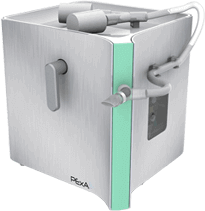How PExA works
By analyzing microscopic particles in exhaled air, we can now get a good overview of the status of the small airways. The method is like a blood sample for lungs, however it is not invasive.
Severe lung diseases, such as COPD, often start with pathological changes in the small airways, but there is currently no non-invasive, user-friendly technology to measure the status of the lungs. The PExA method brings new opportunities and gives researchers an instrument to measure a number of different biomarkers that each represent a potential disease marker or target substance for pharmaceuticals.
Professor Anna-Carin Olin explains

PExA has unique advantages
- The collection is efficient, reliable, and repeatable.
- The collection is non-invasive (i.e. without physical violation) and is easy to implement.
- Sampling can be repeated even on the elderly and the sick.
- The analysis of collected particles provides quantitative as well as qualitative results.

Every breath counts
Particles are formed from the liquid layer in the small airways that opens up and cracks during inhalation. Among these particles there are biomarkers that make it possible to investigate the factors related to various individuals and find out more about the disease’s patient-specific profile of those suffering from COPD, asthma or other serious lung disease.
The method requires the patient first to empty their lungs through a sharp exhalation. Then, the patient breathes in filtered air and breathes out through the mouthpiece.
The exhaled air goes on into the instrument where the particles are sorted and collected on a substrate surface. Deep breathing opens the really small airways and the liquid covering the lung surface cracks releasing microscopic particles. The researchers can then analyse the different particles in the exhaled air. This method really opens up the possibility of deducing the type of inflammation present in the airways.
PExA 2.0
PExA 2.0 has been developed on the basis of the instrument developed at the Sahlgrenska Academy in nine specimens (PExA 1.0) and...
Read More ››Accessories
For each sampling, disposable items are required such as substrate surfaces and nozzles. These components...
Read More ››Research & Development
PExA’s strategy for research is to co-operate with leading international research groups and carry on the work performed...
Read More ››